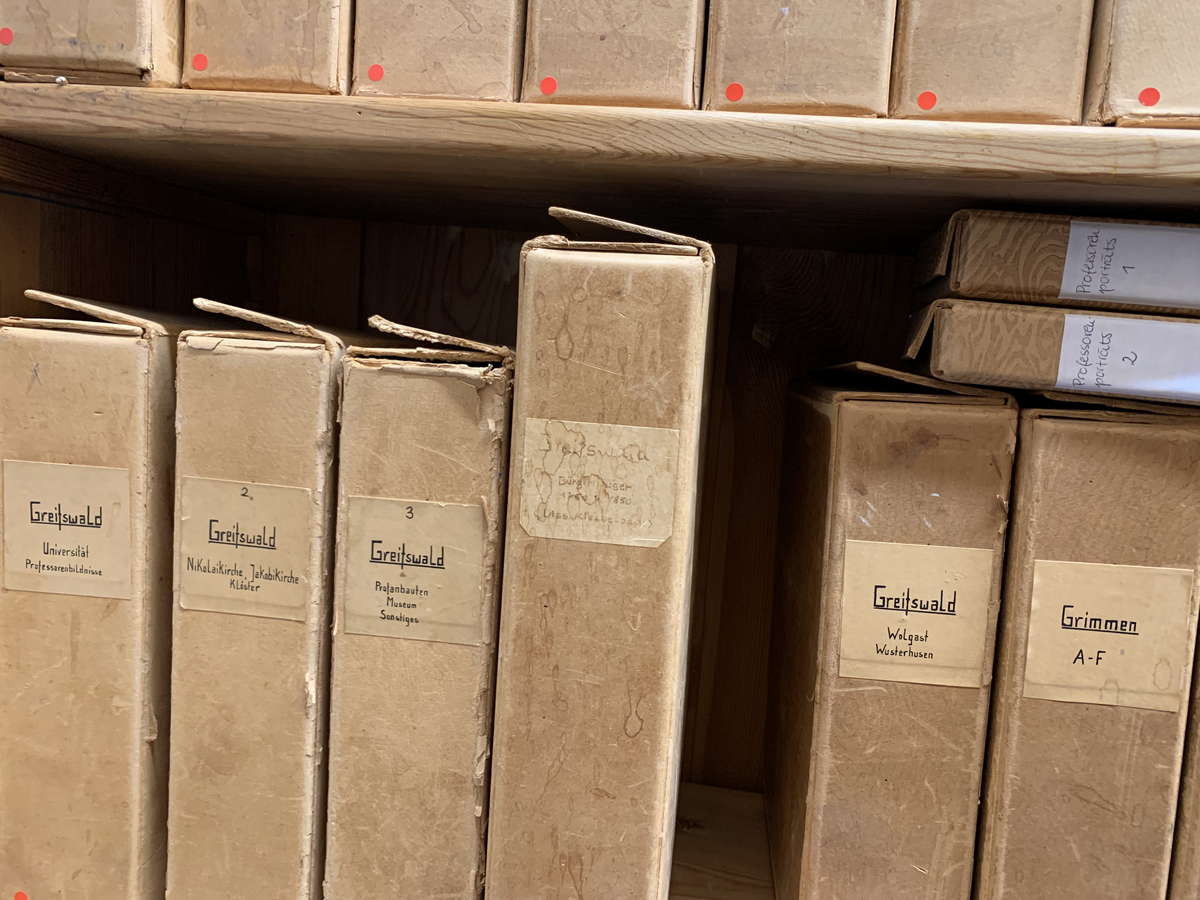The CDFI Picture and Slide Archive
The collections of the CDFI Picture Archive are currently being successively digitised and incorporated into the University of Greifswald's Easy-DB. Once this has been completed, the collections of the Slide Archive will also be digitised.
For research enquiries or general information, please contact:
Susanne Drutsch, M.A.
Tel.: +49 3834 420 3251
History of the CDFI Picture Archive
The Picture Archive belonging to the field of the History of Art at the CDF Institute is located at Rubenowstraße 2b. It is stored there in two basement rooms and managed by the CDFI's History of Art section. The Archive's main holdings are photographs, photographic reproductions and illustrations from publications, as well as a number of large slide series that form part of its core collection that is valuable from a documentary perspective.
The origins of this picture collection can be traced back to 1906/07, when initial preparations were made for the establishment of a history of art seminar at the University of Greifswald. In the following three and a half decades, i.e. until around 1944, the Picture Archivewas enlarged, supplemented and completed on a relatively regular basis, as its teaching, study and research materials represented the most significant part of the works used for reference. The picture collection also includes documents that were created in connection with the inventory and research activities at the Greifswald seminar and Department of the History of Art, which in the 1920s, 1930s and 1950s focussed in particular on regional art history as well as on brick architecture in the Baltic Sea region and Romantic art. The collections of the Picture Archive thus almost completely reflect the development of the academic discipline of history of art within the local and regional setting of Greifswald and (Vor-)Pommern from its beginnings until the 1960s.
This collection of pictures, which has now become "historical", is quite heterogeneous. The majority has been organised topographically and according to main genres, epochs and periods and is stored in a total of 518 sturdy boxes. Many of the old photos have been mounted on cardboard or glued and labelled. The most important picture documents are probably to be found in the 109 boxes containing various images of Pomerania's architectural and artistic monuments. These include a number of photographs from the period before and around 1900, but many of the photos from the 1920s and 1930s are also likely to be of great documentary value. These include duplicates from the Königlich Preußische Messbildanstalt (founded in 1885) and its successor, the Staatliche Bildstelle Berlin (since 1921), photographs of architectural archaeological investigations as well as reproductions and tracings of architectural drawings dating from the 19th century. The old photographs of artistic objects and buildings in Mecklenburg, which can be found in 7 boxes, and the contents of a further 21 boxes containing pictorial documents on the history of art in Scandinavia are of equal importance. In addition, there are 184 boxes with examples of pictures related to the history of art in Germany (the most recent additions are 5 boxes with examples of "GDR art"). The archive also contains pictorial examples of the history of art in Italy (82 boxes), France (25 boxes), the Netherlands (27 boxes), England (7 boxes) and Spain (6 boxes). In accordance with the traditions of this subject, there are also 19 boxes with some pictorial material on ancient, early Christian-Byzantine and non-European culture and history of art. In addition, there is a series of 67 picture albums with small-format photos, documenting the spectrum of a Europe-based universal history of art.
The second main component of the archive are the large slides (8 x 8 cm), which are also organised according to topography, epochs and genres and stored in a total of 259 wooden boxes. At a rough estimate, there could be around 20,000 slides. Most of them date from between 1900 and 1940 and are predominantly slide series produced and provided by well-known companies (e.g. E. A. Seemann-Seestern-Lichtbilder Leipzig / Dr Franz Stoedtner, Institute of Projection Photography, Berlin / Th. Benzinger, Lichtbildverlag Stuttgart / A. Krüss, Optisches Institut Hamburg / Brüder Alinari, Florence). A considerable number of these slide series originate from the former Greifswald Archaeological Seminar or the Department of Classical Studies and were adopted by the History of Art (in 143 boxes). The custom-made large slide series that show architectural and artistic monuments of Pomerania in historical states from the time before the Second World War (in 37 wooden boxes), have high documentary value.
Among the large collection of 35mm slides, which fill several metal cabinets in one of the archive rooms, are a number of photographs of neighbourhoods and individual buildings in historic centres as well as suburban development areas in East German towns from the "GDR era", which were individually produced for the "History of Art" research area. It is clear that these slides must now also be counted among the picture sources relevant to contemporary history.
M.Lissok, Greifswald (last revised April 2024)

